I should begin by prefacing that the food at Bali Silent Retreat is not traditional Balinese, in fact it’s very different from what I understand. However, in my opinion the food is one of the best parts of the retreat and meals are certainly one of my favorite parts of the day.
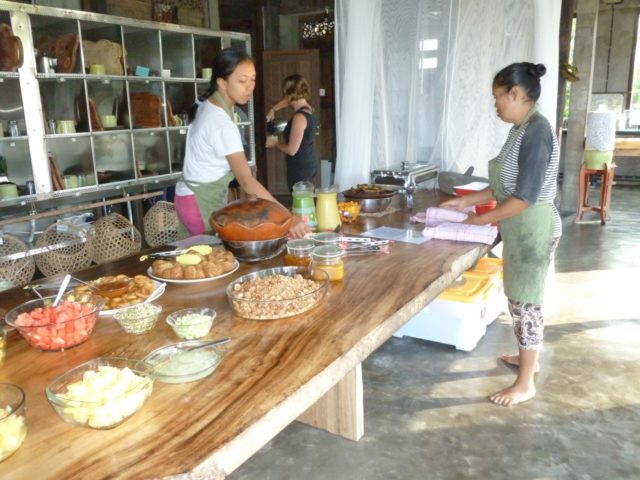 The chef of the retreat is from Holland and is very passionate about food and the way it is grown and produced. He gives a weekly talk to the retreat guests about his philosophy and speaks about how the way that food is grown often times is harmful to the earth not only because of pesticides and other additives, but also because we are not honoring the way our mother can naturally provide for us. Instead, most farmers choose a piece of land and decide that they are going to grow certain things that aren’t necessarily natural or native to that soil and climate. In turn, this leads to the use of unnatural fertilizers, hormones, pesticides, etc., harming the planet and altering the benefits of the foods for our bodies. If we were to just allow the earth to do its thing and grow food naturally, it would produce its own compost and fertilizers, take care of the pests on its own and produce food that would not only nourish our bodies but the planet as well.
The chef of the retreat is from Holland and is very passionate about food and the way it is grown and produced. He gives a weekly talk to the retreat guests about his philosophy and speaks about how the way that food is grown often times is harmful to the earth not only because of pesticides and other additives, but also because we are not honoring the way our mother can naturally provide for us. Instead, most farmers choose a piece of land and decide that they are going to grow certain things that aren’t necessarily natural or native to that soil and climate. In turn, this leads to the use of unnatural fertilizers, hormones, pesticides, etc., harming the planet and altering the benefits of the foods for our bodies. If we were to just allow the earth to do its thing and grow food naturally, it would produce its own compost and fertilizers, take care of the pests on its own and produce food that would not only nourish our bodies but the planet as well.
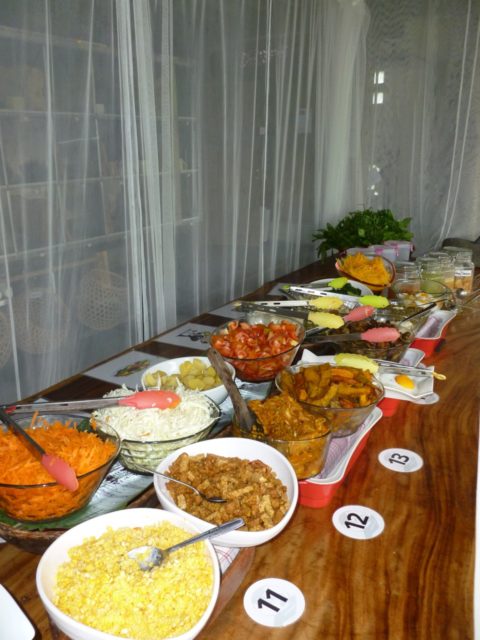 That is essentially the way the food is grown at the retreat. Most of the food that we eat is grown at the retreat either in the gardens or around the grounds of the retreat, and some of it is picked just hours before we consume it. The food that is not grown at the retreat is purchased locally on the island and always grown naturally without additives. All of the food is vegetarian and dairy free; the climate in Bali doesn’t support dairy cows. The only animal products that are served are free range duck eggs from ducks that are used as part of the harvesting process in the rice fields. At a certain point in the rice harvesting cycle, the ducks are taken into the fields to eat the worms and other “pests” in lieu of using pesticides and in turn the ducks end up laying eggs that are incredibly rich and delicious and are used as a source of protein in many of the dishes at the retreat.
That is essentially the way the food is grown at the retreat. Most of the food that we eat is grown at the retreat either in the gardens or around the grounds of the retreat, and some of it is picked just hours before we consume it. The food that is not grown at the retreat is purchased locally on the island and always grown naturally without additives. All of the food is vegetarian and dairy free; the climate in Bali doesn’t support dairy cows. The only animal products that are served are free range duck eggs from ducks that are used as part of the harvesting process in the rice fields. At a certain point in the rice harvesting cycle, the ducks are taken into the fields to eat the worms and other “pests” in lieu of using pesticides and in turn the ducks end up laying eggs that are incredibly rich and delicious and are used as a source of protein in many of the dishes at the retreat.
I am not a vegetarian, but my body has felt totally nourished on the food here. I have lost weight and my digestion has been very healthy. My body seems to prefer to be vegetarian; when I was in India I ate vegetarian food for a month and dropped over 10 lbs. I stopped eating gluten about three years ago because I was having trouble with my skin and while it helped my skin, it didn’t completely fix my problems. Still, I never felt the urge to go back to gluten because of the way it is modified and processed in America; I don’t believe it’s good for our digestion anyway. But I’m also not sure that all of the gluten free substitutes which tend to contain a lot of corn are any better. Either way, I decided that while I am traveling I am not going to deprive myself of anything and especially since I’ve been eating vegetarian and dairy free here I have been indulging a bit on wheat products. The bread is baked fresh every morning and I am sure that the wheat is produced in a way that is natural and additive free. So far I haven’t had any issues with my skin or my digestion, perhaps because I don’t have a wheat or gluten intolerance, or perhaps because of the difference in the way it is processed.
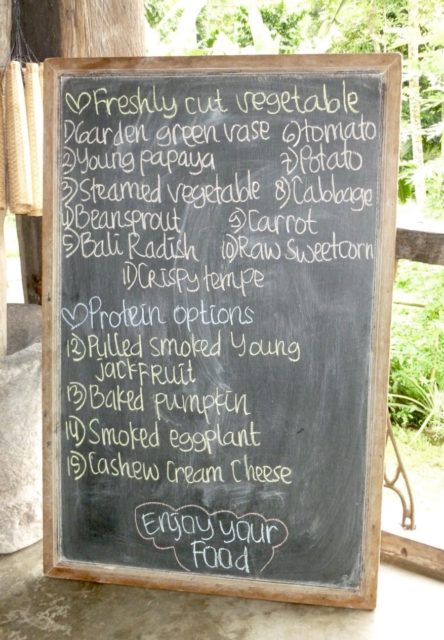 Meals are one of my favorite parts of the day at the retreat. One thing that I particularly appreciate is having delicious and healthy meals prepared for me three times a day and not having to do any of the work. I enjoy cooking and love to eat my own cooking, but it is also nice to have a break. Every meal has 10-12 options to choose from; I never knew there were so many possibilities with vegetarian food! Breakfasts always include fresh fruit from the garden, homemade granola with cashew milk and fresh green smoothies as well as another fresh juice – usually papaya or watermelon. In addition there are usually 2-3 savory items one containing duck egg (poached, baked, scrambled with veggies, omelets, frittatas, Moroccan baked eggs), some sort of potato or root hash brown and something like veggie sausages or eggplant “bacon.” There is often some sort of rice porridge, usually sweet with some sort of fruit but sometimes they have a savory porridge with onions and veggies (my favorite!), and something else that is sweet – pumpkin pancakes, baby pumpkin muffins, raw cacao cakes, mini pies with cashew cream and fresh fruit jam and many other items that seem more like dessert than breakfast but I don’t mind indulging in them knowing that they are nourishing my body.
Meals are one of my favorite parts of the day at the retreat. One thing that I particularly appreciate is having delicious and healthy meals prepared for me three times a day and not having to do any of the work. I enjoy cooking and love to eat my own cooking, but it is also nice to have a break. Every meal has 10-12 options to choose from; I never knew there were so many possibilities with vegetarian food! Breakfasts always include fresh fruit from the garden, homemade granola with cashew milk and fresh green smoothies as well as another fresh juice – usually papaya or watermelon. In addition there are usually 2-3 savory items one containing duck egg (poached, baked, scrambled with veggies, omelets, frittatas, Moroccan baked eggs), some sort of potato or root hash brown and something like veggie sausages or eggplant “bacon.” There is often some sort of rice porridge, usually sweet with some sort of fruit but sometimes they have a savory porridge with onions and veggies (my favorite!), and something else that is sweet – pumpkin pancakes, baby pumpkin muffins, raw cacao cakes, mini pies with cashew cream and fresh fruit jam and many other items that seem more like dessert than breakfast but I don’t mind indulging in them knowing that they are nourishing my body.
 Lunches are always a do-it-yourself salad. There are greens from the garden, sometimes lettuce but mostly other types of edible greens, as well as an array of other fresh vegetables – fresh sweet corn, tomato, cucumber, carrot, Bali radish, cabbage, veggie proteins like sprouted mung beans, tempeh, roasted eggplant and pumpkin, pulled smoked young jackfruit (prepared like pulled pork, delicious) and several fresh dressings. There is always freshly baked sourdough bread with homemade peanut butter or cashew “cheese” that is delicious on the bread.
Lunches are always a do-it-yourself salad. There are greens from the garden, sometimes lettuce but mostly other types of edible greens, as well as an array of other fresh vegetables – fresh sweet corn, tomato, cucumber, carrot, Bali radish, cabbage, veggie proteins like sprouted mung beans, tempeh, roasted eggplant and pumpkin, pulled smoked young jackfruit (prepared like pulled pork, delicious) and several fresh dressings. There is always freshly baked sourdough bread with homemade peanut butter or cashew “cheese” that is delicious on the bread.
Dinners always have some sort of soup (which is my favorite part of dinner); pureed soups like pumpkin and tomato, eggplant or mung bean, chunky soups like vegetable minestrone or slow cooked cabbage, carrot and red harvest rice, and one night they had a cold papaya soup with tomatoes and cucumber – so yummy! There are also typically several raw vegetable salads with different dressings, some type of curried potato/mung bean/vegetable dish and several dishes with duck egg or papaya (not necessarily together). I never really cared much for papaya until I ate it fresh in tropical climates, but after my stay here I have a new found love for papaya. 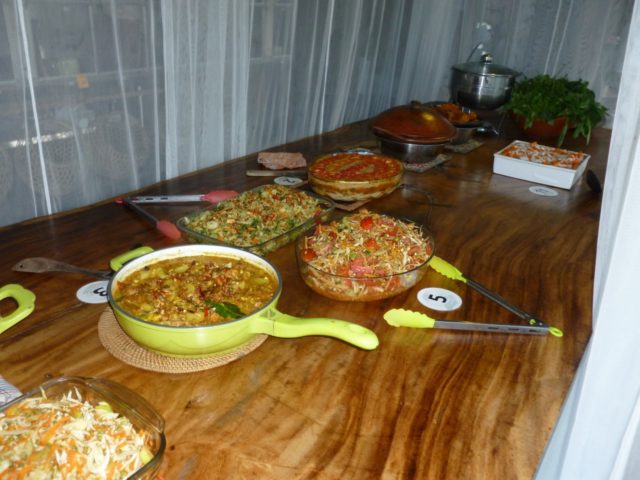 It is so versatile! It is often cooked in many of the dishes and adds a light sweetness and soft texture, it is sometimes served raw with salt and pepper, or young papaya is sliced thinly in different salads or as a lasagna “noodle.” Mung beans are also used in many of the dishes as an added source of protein and I just love that creamy, rich little bean that is also very versatile. There are sometimes gnocchi dishes, calzones or steam buns stuffed with veggies and beans, I could go on and on. And of course delicious desserts like chai banana pudding with fresh chocolate, pumpkin cacao brownies, deep fried breaded bananas with chocolate sauce…oh my. I try to only eat the desserts a couple times a week, but I usually let myself indulge on whatever else I want because I know how healthy and nourishing this food is for me.
It is so versatile! It is often cooked in many of the dishes and adds a light sweetness and soft texture, it is sometimes served raw with salt and pepper, or young papaya is sliced thinly in different salads or as a lasagna “noodle.” Mung beans are also used in many of the dishes as an added source of protein and I just love that creamy, rich little bean that is also very versatile. There are sometimes gnocchi dishes, calzones or steam buns stuffed with veggies and beans, I could go on and on. And of course delicious desserts like chai banana pudding with fresh chocolate, pumpkin cacao brownies, deep fried breaded bananas with chocolate sauce…oh my. I try to only eat the desserts a couple times a week, but I usually let myself indulge on whatever else I want because I know how healthy and nourishing this food is for me.
I do plan to eat meat once I leave the retreat, not wanting to deprive myself of anything while I’m traveling. But since I will be ending my trip with 6-8 months in India, I will likely go back to vegetarian while I am there and hopefully that will inspire me to just continue when I return home. And I have a new inspiration to support local farmers, not only for my own health but for the health of the planet. If you’re interested in learning more about the chef, his philosophy on food and even get some recipes, check out his website… https://newearthcooking.com

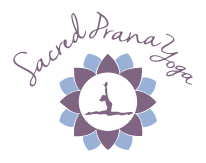

Sounds amazing!!!!